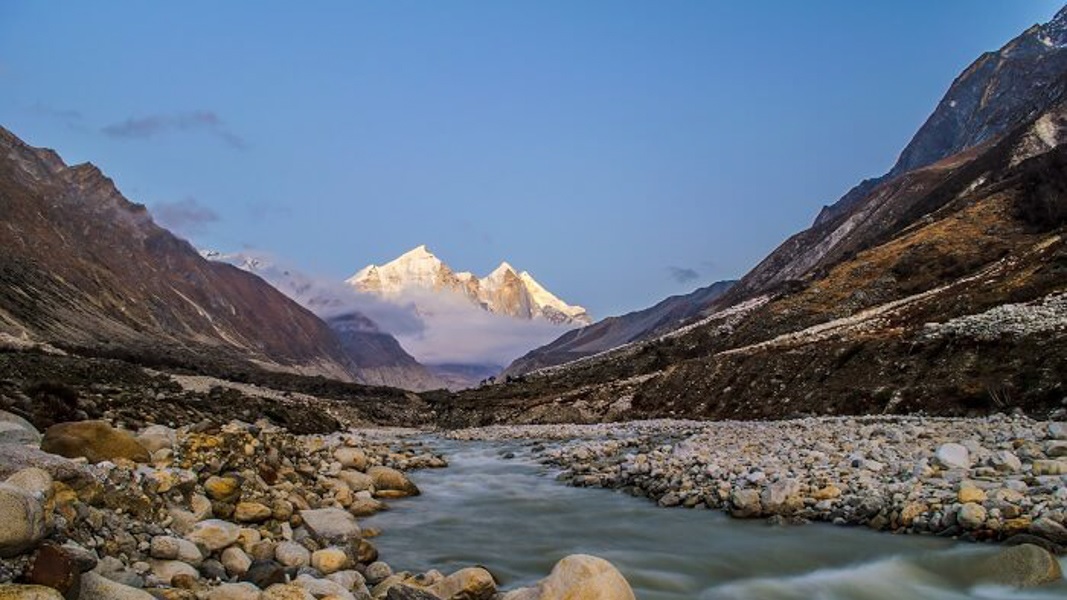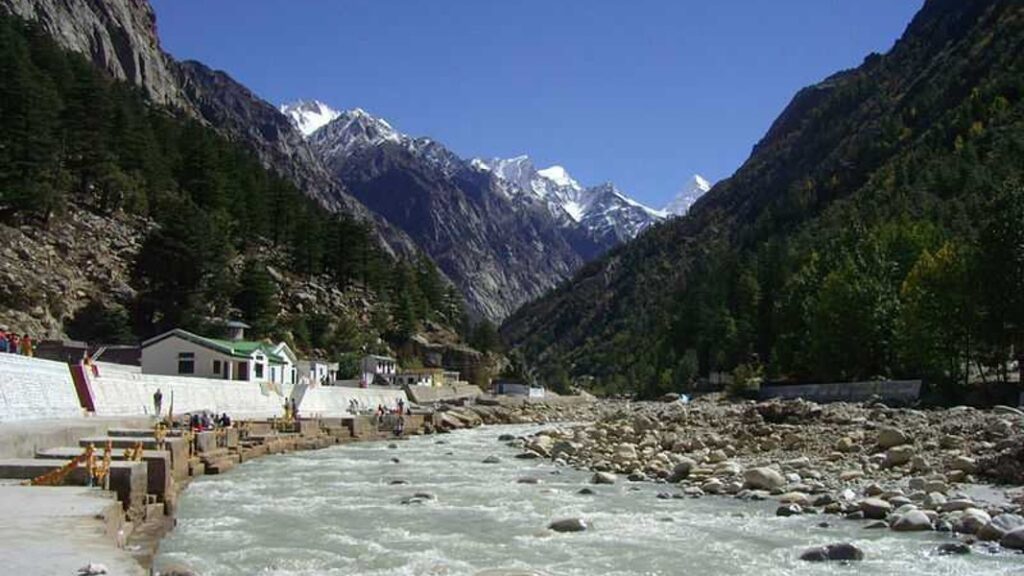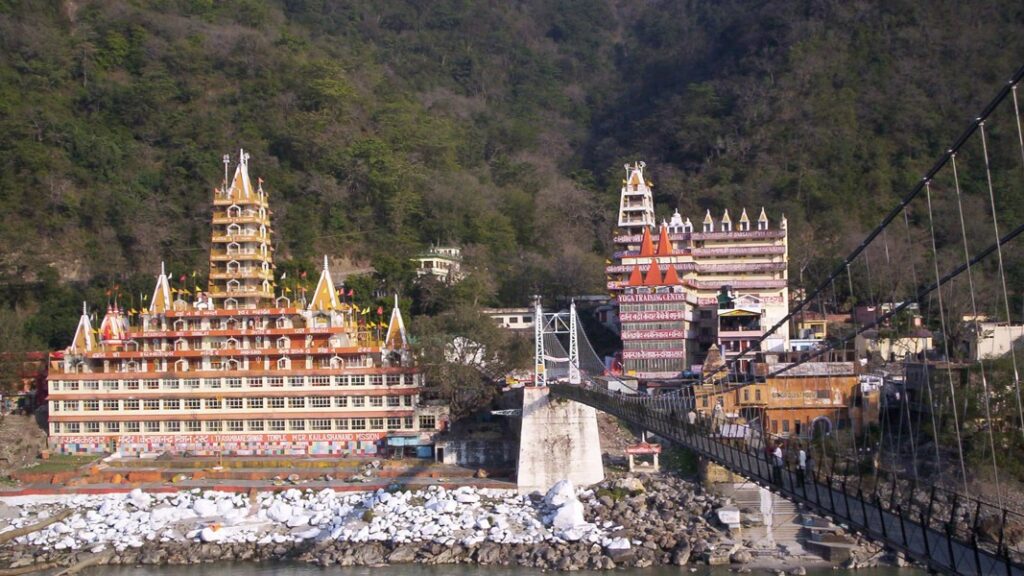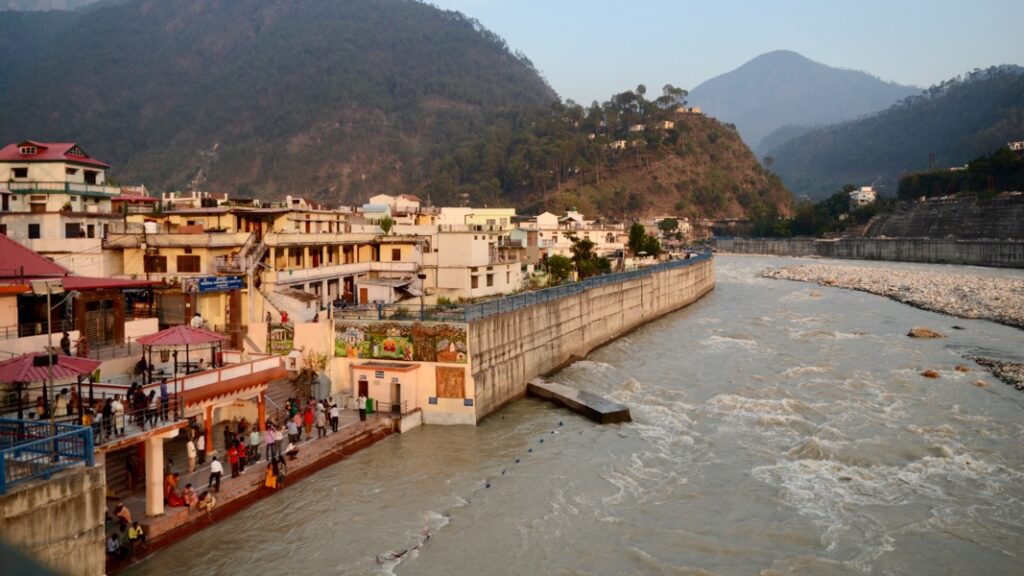
India Trekking to the source of the Ganges !!
The India Trekking – To the Source of the Ganges takes us along the holy Ganges to its source Gaumukh. The onward route takes us over the Gangotri glacier further up to the beautiful meadow of Tapovan. The meaning of Tapovan is forest of deprivation or spiritual practice. This is an ideal trek for adventure seekers who want to discover nature and experience the mighty Himalayas at high altitude.
In technically easy stages we hike in the southern part of the largest mountain range in the world. Our daily stages allow us to acclimatize well. The highest planned point on this tour is at 4500m. We start and end this scenic India trekking in the capital Delhi. We experience the culture of India up close with many temples and their historical sites. We can also attend the ritual washing in the holy river Ganges. The ritual ablution serves to get closer to one of the life goals of the Hindus, “Moksha” – salvation.
To the source of the Ganges means that we hike to Gaumukh. The source of the Ganges is fed by one of the largest glaciers in the Himalayas. This lies amidst the snow-capped peaks of the Garhwal Himalayas.
Garhwal is a region of ancient temples, holy rivers, ancient history and folklore, a land mentioned in the ancient history of India. The Ganges is one of the largest rivers on earth and you will hardly find a river that is more revered and sacred than the Ganges.
The first half of the trek takes us to the Dayara Bugyal. Bugyals are alpine pastures or meadows at higher altitudes between 3,300 and 4,000 meters. They are considered to be one of the most beautiful and breathtaking alpine meadows in the Himalayas.
The panoramic view from these meadows of the nearby mountains Banderpunch, Kalanag and Gangotri is simply breathtaking. We always move between high mountains, all of which exceed the 5000m, 6000m and 7000m mark. An unforgettable moment is the view of Shivling 6543m, the Matterhorn of India.
Qualified, local and very experienced guides lead you to the source of the Ganges.
Day 1: Arrival in Delhi.
Upon arrival at New Delhi International Airport greet by our representative & transfer to hotel for overnight stay. After dinner, we are given instructions for the next few days.
Day 2: Delhi – Haridwar (Train) – Drive to Rishikesh

Early in the morning, we take the train to Haridwar, about 5 hours away.
Haridwar is already at the foot of the Himalayas. The onward journey takes us to Rishikesh.
In this pilgrimage city, we can visit historical Hindu temples and sites.
The ritual washing in the holy river Ganges is particularly impressive, in order to get closer to one of the Hindus’ life goals, “Moksha” – salvation.
In the evening, we visit the market and Ganga Aarti in Parmarth Niketan.
We spend the night at the Hotel Niraj Ganga Heritage (or similar).
Day 3: Rishikesh – Barsu (Uttarkashi)
Today, we have a 200km transfer to Barsu at 2200m. The journey is varied and at times adventurous through the wooded foothills of the Himalayas. We pass Indian recreation resorts, old temples and shrines.
Overnight stay at the Dayara Resort Hotel (or similar).
Day 4: Barsu – Barnala Bugyal (Hiking)
After breakfast we start our hike to Barnala Bugyal. We follow a gentle path uphill through beautiful rhododendron and oak forests. On a clear day we can catch our first glimpse of the Gangotri Himalayas. As soon as we approach the tree line we reach the small summer settlement of Barnala (2,580 m), where we will have our picnic lunch. After lunch we continue our hike towards Barnala Bugyal and then enter the dense mixed forest. After a few hours we reach our camp Dayara Bugyal at 3050 m. We spend the night in the camp.
Walking time approx. 4-5 hours, ascent 800 m, descent 100 m, 8km
Day 5: Barnala Bugyal – Bakaria Top

After breakfast we hike along the meadows and gradually gain altitude until we reach Bakaria Top. Dayara Bugyal is divided into many small bugyals and Bakaria Top is one of them. The view from the summit is breathtaking. The snow-capped mountains, the valley below and the towns as far as Uttarkashi can be seen from up here. From here you have a 360-degree panoramic view of the entire Himalayas.
Breathtaking views of the Bandar Punch massif, the Black Peak, Srikanth and the Gangotri mountain range. From the summit the path leads along the ridge to Syari Bugyal 3400m, from where you have a wonderful view of the Himalayas.
We spend the night in the camp.
Walking time approx. 4-5 hours, ascent 600 m, descent 200 m, 7km
Day 6: Bakaria Top – Barsu Village
We have a day to explore Surya peak 3900m with its magnificent views of Gangotri Himalayas. After breakfast we can continue up the valley to Surya peak and further to Uchlaru peak which offers 360 degree views of Himalayas including Bandarpoonch (6350m), Draupadi Ka Danda (6420m), Jaonli (6600m), Srikanth, Gangotri I, II, III and many other peaks. We have plenty of time to enjoy the views before returning to camp and descending to Barsu village. It is a long descent to Barsu 2230m through the dense oak, cedar and rhododendron forest.
Overnight at Guest House.
Walking time approx. 5-6 hours, ascent 500 m, descent 1670 m, 12 km
Day 7: Barsu Village – Gangotri (Drive)

Today we transfer to Gangotri 3050m. We will need about 3 hours for the almost 100km.
We drive deeper into the steep Bhagirathi valley and the landscape quickly becomes more dramatic. After checking in at our lodge, we visit the temple of the goddess Ganges, which was built by the Gorkha general Amar Sing Thapa in the early 18th century, as well as various other temples in the area.
Overnight stay in the guest house.
Day 8: Gangotri – Bhojbasa (Hiking)
Today we hike through oak and pine forests to Chirbasa and then over the tree line to Bhojbasa 3790m.
After breakfast we start with an easy climb, which offers us a wonderful landscape to Chirbasa with every step. We continue through pine and birch forests (Bhojpatra) to Bhojwasa. The entire hike on this day runs along the roaring Bhagirathi river. During the hike we have a great view of Mt. Manda (6510 m), the Bhagirathi massif and other surrounding peaks.
Bhojwasa means “home of the birch trees”. We reach the camp in the evening. Just above the camp we have our first glimpse of the Shivling peak (6543m), the Matternhorn of India.
We spend the night in the camp.
Walking time approx. 5-6 hours, ascent 750 m descent 0 m, 14km
Day 9: Bhojbasa – Gaumukh – Tapovan

Today the trek takes us to Gaumukh and to the extensive meadows of Tapovan 4500m.
From Bhujbasa we hike towards Gaumukh. The sages called it “Gomukh” because in ancient times it probably looked like a cow’s mouth. Before we turn onto the Gangotri glacier, we descend the lateral moraine and follow a marked path that leads to the east side of the glacier. We continue to Tapovan (4,500 m), one of the most beautiful high-altitude pastures in the area, surrounded by Shivling (6,543 m), Meru (6,660 m), Kharchkund (6,632 m) and the Bhagirathi peaks (6,853 m).
Tapovan comes from the two root words tapas – which means penance, religious mortification and austerity, and more generally, spiritual practice – and vana, which means forest or thicket. Tapovan therefore means forest of austerity or spiritual practice.
We spend the night in the camp.
Walking time approx. 4-5 hours, ascent 750 m, descent 100 m, 8km
Day 10: Tapovan
The day in Tapovan offers us the opportunity to hike to Mount Meru base camp.
We have time to acclimatize, relax and enjoy the magnificent snow-capped peaks, the flora and fauna and the mountain landscape.
An optional day hike to Mt. Meru base camp is possible.
We spend the night in the camp.
Walking time approx. 2-3 hours, ascent 400 m, descent 400 m, 4km
Day 11: Tapovan – Gaumukh – Chirwasa

We get up early to enjoy the spectacular sunrise over the surrounding 6,000m peaks, with the Shivling once again being the main event.
After breakfast, an initially steep descent leads down to the glacier and then a gradually flatter path to Chirwasa 3550m.
We spend the night in the camp.
Walking time approx. 5-6 hours, ascent 0 m, descent 1000 m, 9km
Day 12: Chirwasa – Barsu (Uttarkashi)
We descend towards Gangotri 3050m and can relax and take in the nature, the surrounding mountains and the impressions.
The tour concludes with a drive to the small village of Barsu, which takes around 2 hours.
Overnight stay in the Hotel Dayara Resort (or similar).
Walking time approx. 3-4 hours, ascent 0 m, descent 500 m, 9 km
Day 13: Barsu (Uttarkashi) – Rishikesh

We slowly leave the high mountains of the Garhwal Himalayas again and drive to Rishikesh.
The 170 km route takes approx. 5-6 hours.
The rest of the day is then free and you can visit the market and attend the Ganga Aarti ceremony.
We stay at the Hotel Niraj Ganga Heritage (or similar) as accommodation.
Day 14: Rishikesh – New Delhi (Train)
From Haridwar we take the train to Delhi and can once again absorb the magic of this city.
The accommodation is the already well-known Hotel Deventure (or similar).
Day 15: Departure from Delhi
After breakfast we are transferred to the airport.
Alternatively, there are two options for extending the trip.
Visit the world-famous Taj Mahal in Agra or the Golden Triangle combined with Jaipur and Agra.

Difficulty Rating
Our India trekking is a technically easy tour with a few slightly more demanding passages. Nevertheless, the consecutive days with overnight stays in a tent at high altitudes are demanding overall.
Acclimatization takes place during the tour and the maximum altitude is 4500m.
We recommend that you prepare yourself before starting the trip. Weekly training units in the basic endurance area and strengthening of the core muscles are required. This can be done individually.
Hikes and high mountain hikes in the Alpine region are an ideal extension, are fun and increase the anticipation. Tours in the glaciated high mountains also provide personal experience in dealing with and experiencing the “altitude”.
We are happy to help with selected preparatory tours from our range.
Certainty and fitness for walking times of 6 hours on several consecutive daily stages are necessary.
Approx. 800m of ascent and up to 1700m of descent are covered.
Golden Triangle trip extension
To delve even deeper into the culture of India, it is possible to book optional trip extensions.
Day 15: Delhi – Jaipur
Today we’re going to historic Jaipur. The journey from Delhi to the “pink city” of Jaipur takes about five to seven hours. The Mughal city, built in the late 18th century, consists of wide sandstone avenues that were later painted pink. Today we’ll visit the Amer Fort, which is located on a hill and was built by the ruler of the Kachwaha dynasty, Man Singh, and served as the seat of the dynasty before the capital was moved to Jaipur.
We’ll be staying at the Golden Tulip Hotel (or similar).
Day 16: Jaipur Sightseeing
Today is planned for sightseeing in Jaipur.
A full day of sightseeing in and around Jaipur, including the Palace of the Winds, the City Palace and the Amber Palace. In the center of Jaipur is the City Palace, the former residence of the Maharaja, which is now a museum with rare manuscripts, paintings, royal robes and weapons. Near the palace is one of the most fascinating sights in India: the Jai Singh Observatory. It is a collection of huge astronomical instruments made of marble and brass, set in a beautiful garden.
We will also see the impressive symbol of Jaipur, the Hawa Mahal, the Palace of the Winds. Just a few kilometers from the city is the magnificent Amber Palace, which rises above a lake. The imposing fort, located on a hill, has large courtyards and interiors with fine decorations, including inlaid alabaster panels and a chamber of mirrors. We can walk up the hill and enter the courtyard through the massive gate. Jaipur is a center of numerous handicrafts such as durries – woven carpets, rugs, printed fabrics, semi-precious stones, leather goods, etc.
Day 17: Jaipur – Fatehpur Sikri – Agra
After breakfast we drive to Agra. The journey takes about 4 hours. An hour before reaching Agra we stop to visit Fatehpur Sikri, a magnificent abandoned Mughal city.
We stay at the Howard Plaza by Feran or a similar hotel.
Day 18: Agra – Delhi
The day is available for visiting the Taj Mahal (Closed Every Friday) and the Red Fort. The gleaming white marble walls of the Taj Mahal, inlaid with semi-precious stones, amaze every visitor. Near the Taj is the imposing Red Fort of Akbar, the third of the Mughal emperors, whose mighty sandstone walls enclose the beautiful white marble Pearl Mosque and the palaces, halls, courtyards and fountains of his sons and successors Jehangir and Shah Jahan.
In the afternoon drive to Delhi.
We prefer to stay at the Hotel Deventure or a similar hotel.
Day 19: Departure Transfer to onward destination
After breakfast we go to the airport and start the return journey.
Thankyou for reading our page in which we provide information about ” India Trekking to the source of the Ganges !! ” by Delighted Journey